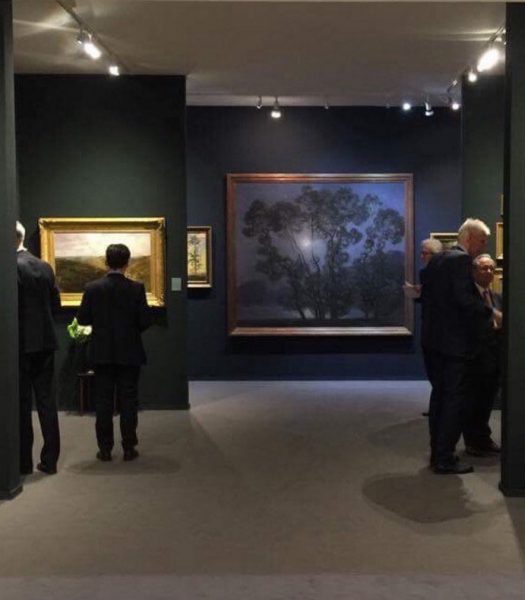TEFAF, The European Fine Art Foundation which is connected to the world’s most exclusive art fair, has released their annual report. This is always the most important barometer of the health of the global art market. The 2017 edition spearheaded by Professor Rachel A. J. Pownall confirms suspicions of a downturn in the international art market. It also identifies positive indicators for certain sub-sectors of the market. Globally, sales of art were down 7% to £51.8 billion/$63.8 billion in 2015, compared to £55.9/$68.2 billion in 2014. A number of art transactions also decreased to 38.1 million, a 2% contraction.
The overall picture of the art market in 2016 is a sturdy, resilient market that is thriving despite global economic and political uncertainty, according to the TEFAF Art Market Report 2017. This year for the first time, the TEFAF Art Market Report has been prepared by Professor Rachel A. J. Pownall, who holds the TEFAF Chair in Art Markets at the School of Business Economics at Maastricht University. Professor Pownall also holds the Van Gogh Chair on Art Finance and Museum Management at TIAS School for Business and Society. The report is written in partnership with the Maastricht Centre for Arts and Culture, Conservation and Heritage (MACCH) at Maastricht University
In terms of headline figures, sales in the global art market reached $45bn in 2016
In terms of headline figures, sales in the global art market reached $45bn in 2016, up nearly 1.7% compared to 2015. The report adopts a focused and specific definition of art dealers and art galleries, representative of the industry at hand. The outcome of this is that overall industry estimates appear smaller than in previous reports but are considered to be more representative of the art and antiques market globally.
Europe remained the most significant continent, with sales exceeding $20.5bn, followed by the Americas ($14.5bn) and Asia (almost $10bn). In specific markets, the US totaled 29.5% of all sales, followed by the UK at 24% and China at 18%.
The greatest change in 2016 was a dramatic drop in the value of global auction sales ($16.9bn), down 18.8% on the 2015 figure ($20.8bn). This was mirrored by the total volume (number of items) sold at auction, which likewise decreased by 21.5%.

The most significant change occurred in the US, where the value of sales at auction dropped by 41% (far exceeding the 9% percent drop in consignments). There was also a 13% drop in the value of auction sales in Europe (from $6bn in 2015 to $5.22bn in 2016). By contrast, the auction market in Asia remained stable. Asia now has the largest share of the global auction market at 40.5%, dominated by China.
The reason for this significant change was a move to private sales. It is noteworthy that dealer revenues in the same period increased by 20-25%. Private sales now account for about 70% of all sales worldwide.
The nature of the dealer market provides collectors, particularly of high-value works, with both privacy and anonymity. Collectors have become more inclined to secure deals away from auction publicity. This has been recognised by the auction houses who have been facilitating a greater number of private sales.
This change has not just meant a shift in the way that auction houses do business, it has also benefitted independent dealers. Private sales through dealers and galleries have been strong in 2016, with retail sales values up 24% over the year. Europe (which is home to 54% of the worldwide dealer community) is 20% larger than last year.
It is also of note that dealers have been changing the way they do business
It is also of note that dealers have been changing the way they do business. The internet (including social media) has gained increased prominence, impacting both the way in which dealers market their expertise and, also, the way in which buyers (their clients) access information. This has been predominantly true of the lower end of the market, with over 75% of sales achieved via a website being below $5,000.
Sales data has also indicated some possible shifts in taste. Collectors appear to have lost their appetite for some traditional blue-chip artists. Works by Andy Warhol, Pablo Picasso, Amedeo Modigliani, Francis Bacon and Cy Twombly, for example, all saw a dramatic drop in their performance at auction. This will have impacted the overall auction house results.

The Asian market has been stable as a whole, but volatile in terms of specific markets. There was no dramatic shift away from auctions, but the antique market contracted by 23.3%, whilst the market for paintings grew by 36%. Auction sales in Japan grew by 101.5% and in India by 110%.
Reflecting the changes noted above, market research has indicated that dealers are optimistic about the future, with 76.1% believing that their customer base will grow and 67% stating that on-line sales platforms, both their own websites and third party sites, are of growing importance and will have a greater impact on their profitability in the future. Furthermore, dealers believe that fairs (both local and international) remain the most effective arenas to acquire new and prospective customers.
Headline figures, sales in the global art market reached $45bn in 2016, up nearly 1.7% compared to 2015. The report adopts a focused and specific definition of art dealers and art galleries, representative of the industry at hand. The outcome of this is that overall industry estimates appear smaller than in previous reports but are considered to be more representative of the art and antiques market globally.
Europe remained the most significant continent, with sales exceeding $20.5bn, followed by the Americas ($14.5bn) and Asia (almost $10bn). In specific markets, the US totalled 29.5% of all sales, followed by the UK at 24% and China at 18%.
The greatest change in 2016 was a dramatic drop in the value of global auction sales ($16.9bn), down 18.8% on the 2015 figure ($20.8bn). This was mirrored by the total volume (number of items) sold at auction, which likewise decreased by 21.5%.
The most significant change occurred in the US, where the value of sales at auction dropped by 41% (far exceeding the 9% percent drop in consignments). There was also a 13% drop in the value of auction sales in Europe (from $6bn in 2015 to $5.22bn in 2016). By contrast, the auction market in Asia remained stable. Asia now has the largest share of the global auction market at 40.5%, dominated by China.
The reason for this significant change was a move to private sales. It is noteworthy that dealer revenues in the same period increased by 20-25%. Private sales now account for about 70% of all sales worldwide.
The nature of the dealer market provides collectors, particularly of high-value works, with both privacy and anonymity. Collectors have become more inclined to secure deals away from auction publicity. This has been recognised by the auction houses who have been facilitating a greater number of private sales.
This change has not just meant a shift in the way that auction houses do business, it has also benefitted independent dealers. Private sales through dealers and galleries have been strong in 2016, with retail sales values up 24% over the year. Europe (which is home to 54% of the worldwide dealer community) is 20% larger than last year.
It is also of note that dealers have been changing the way they do business. The internet (including social media) has gained increased prominence, impacting both the way in which dealers market their expertise and, also, the way in which buyers (their clients) access information. This has been predominantly true of the lower end of the market, with over 75% of sales achieved via a website being below $5,000.
Sales data has also indicated some possible shifts in taste. Collectors appear to have lost their appetite for some traditional blue-chip artists. Works by Andy Warhol, Pablo Picasso, Amedeo Modigliani, Francis Bacon and Cy Twombly, for example, all saw a dramatic drop in their performance at auction. This will have impacted the overall auction house results.
The Asian market has been stable as a whole, but volatile in terms of specific markets. There was no dramatic shift away from auctions, but the antique market contracted by 23.3%, whilst the market for paintings grew by 36%. Auction sales in Japan grew by 101.5% and in India by 110%.
TEFAF reflecting the changes noted above, market research has indicated that dealers are optimistic about the future, with 76.1% believing that their customer base will grow and 67% stating that on-line sales platforms, both their own websites and third party sites, are of growing importance and will have a greater impact on their profitability in the future. Furthermore, dealers believe that fairs (both local and international) remain the most effective places to acquire new and prospective customers.

